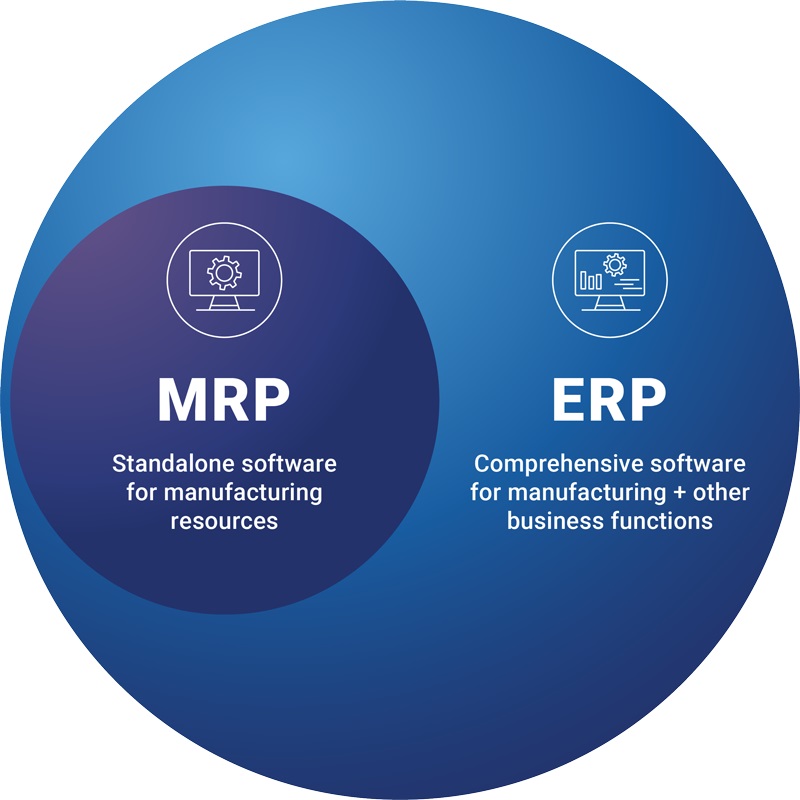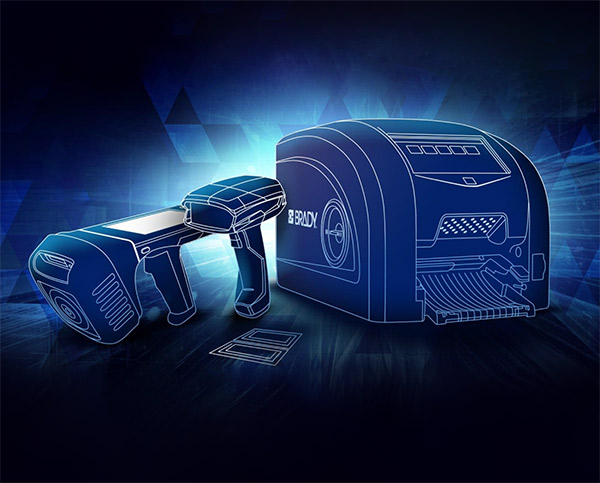Labels for Safety, Visuals and Facility ID Desktop Printers
Labels for Product, Wire and Lab ID Benchtop Printers
Labels for Safety, Visuals and Facility ID Desktop Printers
Labels for Product, Wire and Lab ID Benchtop Printers
Safety and Facility ID Desktop Printers
Product, Wire and Lab ID Benchtop Printers
Barcode Scanner and Printer Kits
Barcode Scanner and Printer Kits
PaintStripe Floor Marking Stencils
Valve Lockouts & Hose Lockouts
Group Lock Boxes & Permit Control
Brady Safety Lockout Tagout Services
Pipe Marker Accessories & Mounting Brackets
Maintenance and Production Tags
Calculators and Assessment Tools
Product Finders and Data Sheets
Material requirements planning (MRP) and enterprise resource planning (ERP) systems help manufacturers and businesses streamline their operations, improve efficiencies and reduce costs. But which solution is right for your business needs and how do they integrate with your current business systems? To help you choose the right system, right off the bat, let’s explore the differences between the systems and how they’re used, integrated and automated.
MRP is a stand-alone software platform for manufacturers that calculates the resources required for production. An MRP system uses information from inventory, the bill of materials (BOM), and the production schedule to calculate inventory requirements, identify when additional supplies are required, and schedule the production or purchase of those supplies. MRPs help manufacturers:
ERP is a compressive software platform that integrates with other business systems to help large companies manage day-to-day business, including manufacturing, purchasing, accounting, sales and marketing, distribution, human resources, customer relations and returns. Many ERP systems also include MRP functions.

Before computerized inventory systems were invented, inventory was recorded by hand. Talk about an inefficient way of planning inventory requirements for production processes.
The first computerized MRP systems were built by airplane engine manufacturers at GE and Rolls-Royce in the early 1950s using mainframe computers and BOMs to determine the inventory required for production. In 1964, MRP software was reimagined by Joseph Orlicky, then commercialized and released for use. Black+Decker was the first to sign up for this new approach. By 1975, MRP systems were implemented in 700 companies, increasing to a massive 8,000 companies just six years later. Obviously, the value was noticed.
Developed in 1983, MRP II software included master scheduling, capacity planning, capacity requirements planning and sales and operations planning. By 1989, it accounted for nearly one-third of the software sold in America.
The acronym ERP was first used by Gartner in the 1990s to describe the functionalities of MRP, MRP II and computer integrated manufacturing systems. ERP has since come to represent the much larger scope of integrated business applications beyond manufacturing and the newer title reflected the growth.
In the early 1990s, ERP added finance, accounting, equipment maintenance and human resources capabilities to the mix. ERP systems experienced rapid growth and just five years later, they evolved to automate the core back-office functions of enterprise businesses. Government agencies and nonprofits began to integrate ERP software. Prior to 2000, many companies replaced old systems with ERP systems to circumvent anticipated Y2K issues.
Gartner coined the acronym ERP II in 2000 to describe the web-based software that accesses ERP systems in real-time. ERP II, also known as an enterprise application suite, expanded the capabilities of ERP to include collaboration between enterprises. The capabilities of ERP II software grew to include front office, vendor-facing functions and customer-facing functions, such as customer relationship management, supply chain management, supplier relationship management, business intelligence, ecommerce and integrations with government procurement systems.
Gartner defines Postmodern ERP as a “technology strategy that automates and links administrative and operational business capabilities,” integrating vendor-delivered benefits with business flexibility and agility. In Gartner’s definition, there are two categories of Postmodern ERP strategy, which can be integrated:
While MRP and ERP software are both forecasting systems that build efficiencies into your business operations, they work differently.
MRP systems are designed to help manufacturers identify inventory requirements on the shop floor and keep production running smoothly. ERP systems manage and facilitate operational and administrative business tasks. Functionalities vary between different ERP systems, and many include MRP capabilities.
See the table below to better understand the functionalities possible for each of the systems.
|
Capabilities
|
MRP
|
ERP
|
|---|---|---|
| Color Printing |
|
|
| Accounting and financials |
|
|
| Customer relationship management |
|
|
| Distribution management |
|
|
| Ecommerce management |
|
|
| eGovernment |
|
|
| Equipment maintenance monitoring |
|
|
| Human resources management |
|
|
| Production planning |
|
|
| Production monitoring |
|
|
| Purchasing/procurement/order management |
|
|
| Raw material monitoring |
|
|
| Ready-to-ship inventory monitoring |
|
|
| Returns management |
|
|
| Sales and marketing |
|
|
| Scheduling |
|
|
| Supply chain management |
|
|
| Supplier relationship management |
|
When deciding between software solutions to improve productivity and add efficiencies to your business operations, it’s important to understand both the benefits and limitations of MRP and ERP systems.
Manufacturers use MRP to streamline production. MRP systems work backward through a production plan to calculate which materials are necessary to produce goods, how much material is necessary, how much required inventory is in stock and when materials are needed. Then, they provide a list of the materials required to produce the final project, covering all the bases needed for an efficient outcome.
MRP is typically suited to larger manufacturers, industrial businesses and factories that need to control production across several production sites, have multifaceted planning and scheduling requirements, and/or need to reduce inventory-related costs.
ERP is an integrated set of applications that enables large companies to manage, unify and coordinate business processes across multiple departments.
Although an ERP may include MRP capabilities, because ERP systems are both costly and complex, they are best suited for large companies and manufacturers that need to optimize workflows across the business, integrate multi-business systems, require visibility into several disparate databases, or have outgrown their current business technologies.
Since many ERP systems have MRP capabilities, a business that has implemented stand-alone systems may benefit from integration. Operating stand-alone MRP and ERP systems will create issues with uncaptured or incorrectly entered data. Additionally, input tasks increase workflow redundancies and decrease efficiencies. You can eliminate the issue and solve it in part by integrating MRP and ERP systems into industrial and factory systems.
The benefits of integration:
Industrial businesses, manufacturers and factories can further improve efficiencies by automating inputs to MRP and ERP systems. As we pointed out earlier, accurate high quality input data is a key to maximizing the value of both MRP and ERP systems. Optical and radio frequency identification (RFID) systems automate moving data into these business systems accelerating the speed of data input and increasing the accuracy and completeness of data. When the right data is immediately accessible, manufacturers can aggregate information across multiple MRP and ERP applications, capture historical trends and employ advanced analytics.
RFID and optical scanning hardware and software seamlessly integrate into ERP and MRP business software systems, enabling businesses to gain new insights and increase productivity with real-time data exchange. With automated data, manufacturers know what’s happening when it’s happening and why. Real-time information empowers businesses to adjust quickly to changing production needs, manage assets and inventory holistically, and scale on demand.
Brady optical scanners, RFID readers and printers are data input and data output hardware for ERP and MRP systems. We write software that smooths out the communication between systems: automating, error proofing and increasing the speed of data delivery.
Specifically:

Brady’s Intelligent Manufacturing Solutions use edge computing and industrial data exchange to seamlessly integrate RFID tracking hardware and software, optical data capture, label printers and label materials with ERP/MRP software, data analytics, cloud API and data warehouses.
How the experts at Brady can help you
Choosing and implementing an MRP or ERP system can be challenging and time-consuming. Brady provides cutting-edge technology solutions to streamline your business operations along with the tools and expertise you need to implement, automate and connect it all. Let us help so you get off to the right start, right away.


Gain immediate insights into your production systems and shift productivity into overdrive.
Analyze real-time data across your operations to make well-informed decisions in no time.
Implement world-class identification technologies with the world’s most trusted manufacturing leader.